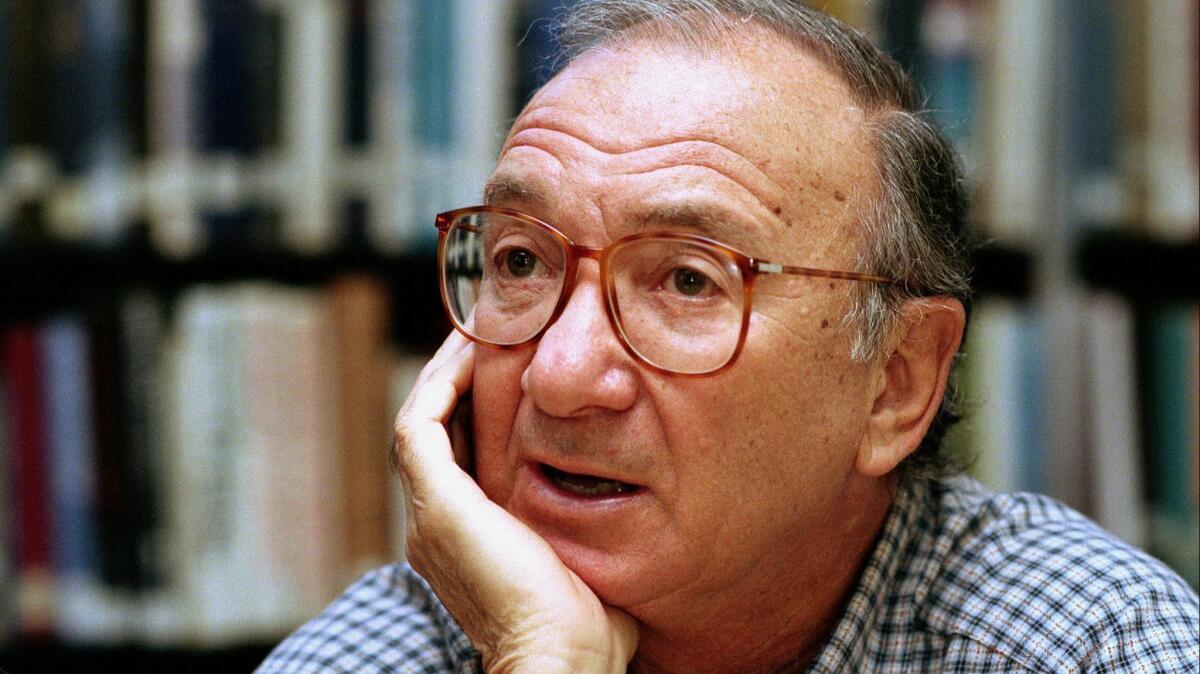Appreciation: Neil Simon: How the playwright wrote his own second act and finally won over critics

It may be hard for niche-inhabiting denizens of the internet era to appreciate the phenomenal popularity of playwright Neil Simon, who died Sunday at 91. When his name was regularly on the marquees, the theater was the center of the middle-class universe.
In “The Season: A Candid Look at Broadway,” author William Goldman stands outside the Plymouth Theatre on a cold February morning in 1968 after Simon’s “Plaza Suite” had opened. The line for the box office tripled in a couple of hours and never seemed to shorten throughout the day.
Who were these theatergoers undeterred by the news that the first available Saturday night seats were in April? They were, according to Goldman, “well dressed, most of them — men with briefcases, women with children in strollers — and they were perfectly content to stand there, waiting their turn to buy tickets for the first real blockbuster to hit Broadway in 798 days” — the period of time since Simon’s last smash.
Box office queues vanished with the click of a mouse, but musicals, as “Hamilton” has spectacularly shown, can still draw huge crowds. “Plaza Suite,” however, is a comedy composed of three playlets all set in the same posh hotel room overlooking Central Park. The cast, under the direction of Mike Nichols, included two luminaries of stage and screen, Maureen Stapleton and George C. Scott. But the real draw was the guy who had previously written “The Odd Couple,” “Barefoot in the Park” and the book for the musical “Sweet Charity.”
Simon’s name at this point was a Pavlovian trigger for laughter. The playwright began as a sketch comedy writer, teaming with his brother, Danny, on Sid Caesar’s “Your Show of Shows,” where he became part of a brain trust of funnymen (Mel Brooks, Carl Reiner, and, of course, Caesar himself) who would go on to shape America’s postwar sense of humor.
The leap to Broadway, motivated by the desire to stay in New York after the rest of the best of television relocated to Hollywood, turned out to be a golden move: Simon’s first major solo debut, “Come Blow Your Horn,” ran for more than a year and half.
Simon dominated Broadway in the 1960s and ’70s, becoming America’s most commercially successful playwright with a cavalcade of hits that included “The Prisoner of Second Avenue,” “The Sunshine Boys,” “California Suite” and “Chapter Two.” He wrote the books for the musicals “Promises, Promises” and “They’re Playing Our Song.” And his film adaptations of his Broadway comedies along with his original screenplays only amplified his already staggering success.
Simon’s name was a Pavlovian trigger for laughter.
Actors collected trophies for making Simon’s zingers sound custom-made for their sharp tongues. Maggie Smith won a supporting actress Oscar for playing a diva in “California Suite” who returns to her hotel room spitting tacks at her husband after losing out to another actress at the Academy Awards. (Smith’s Diana, vainly trying to avoid all out war with Michael Caine’s Sidney: “I have just thrown up on some of the best people in Hollywood. Now is no time to get sensitive.”) But insecurity dogged the man whose hilarity made his producers so rich they named a Broadway theater after him.
Simon suffered at the hands of critics, who objected to the way characters were easily sacrificed for the sake of a good punchline. Complaints about superficiality and schmaltz were regularly leveled against his plays. Intellectuals dismissed him as a clever sketch-writer and sentimentalist with a lucrative genius for giving the audience what it wanted.
“I am not without my supporters, but I often feel it will go no further than Clive Barnes’ succinct evaluation: ‘Neil Simon is destined to remain rich, successful and underrated,’” Simon wrote in the introduction to a volume of his plays. He made clear, however, that, painful as this assessment might be, he had no desire to be “poor, unsuccessful and overrated.”
Yet the slights and the snubs haunted him. In his memoir “Rewrites,” Simon recalls an encounter outside of Sardi’s with New Yorker film critic Pauline Kael, who long had him in her caustic crosshairs. Waiting for a taxi after an awards event on a rainy night, she turned to him with a half-smile and said, “I haven’t been awfully nice to you over the years, have I?” Simon answered, “No, you haven’t,” to which she imperiously replied before slipping into a cab, “Well, it’s hard not to knock you. You keep coming around so often.”
When asked by the Paris Review what his great gift was as a writer, Simon pointed to the “construction” of his comedies, which are typically built around a dilemma involving characters of opposing wills and wants. “By the time you know the conflicts, the play is already written in your mind,” Simon explained. “All you have to do is put the words down. You don’t have to outline the play, it outlines itself.”
Eugène Scribe, the 19th century French dramatist who was one of the principal architects of the genre known as the “well-made play,” once remarked, “When my story is right, when I have the events of my play firmly in hand, I could have my janitor write it.” Not anyone could simulate Simon’s wit or talent for surprise, but a similar formulaic quality characterizes the boffo hits that established his reputation.
Nothing ages faster than comedy. But in revivals of “The Odd Couple” and “The Sunshine Boys,” it wasn’t so much the rat-tat-tat banter as the lumbering set-ups and wheezing momentum that made the plays seem so fusty. Reprise 2.0’s recent production of “Sweet Charity” confirmed that the main impediment to the show’s 21st century life is the musical’s hoary dramaturgy. My own affection for Simon’s early works, which can still leave a laughing audience gasping for breath, is based more on nostalgia (his plays serve as a cultural time capsule) than on playwriting sophistication.
Had Simon ended his theatrical career after the 1970s, he would have gone down as a Broadway legend whose audience-pleasing comedies captured the fading neck-tie-wearing zeitgeist as it was being rocked and rattled by the long-haired counterculture. But Simon wrote himself a second act that changed the trajectory of his career.
It all began with “Brighton Beach Memoirs,” the first play in an autobiographical trilogy that compelled Simon to probe deeper into himself and the background that shaped him. In his New York Times review, Frank Rich announced that the author “makes real progress toward an elusive longtime goal: He mixes comedy and drama without, for the most part, either force-feeding the jokes or milking the tears.”
Rich acknowledged the customary lapses (“We feel that a brisk, superficial glibness is papering over the rough edges of the lives in view — especially the hero’s”), but concluded with the hope of a sequel. Simon, as sensitive to praise as he was to criticism, delivered in short order “Biloxi Blues” and “Broadway Bound,” the other plays in the Eugene trilogy, named after Simon’s youthful surrogate.
“Biloxi Blues” won the 1985 Tony for best play, Simon’s second after “The Odd Couple.” “Broadway Bound” the following year was heralded for Linda Lavin’s Tony-winning performance in the role inspired by Simon’s mother. The retrospective trilogy, the pinnacle of this prolific playwright’s achievement in the theater, paved the way for “Lost in Yonkers,” which received both the 1991 Tony Award and the Pulitzer Prize.
These works, all directed by Gene Saks, didn’t gain Simon entry into the elite club that counts Eugene O’Neill and Tennessee Williams as members. I’ve never taught them in any of my university seminars, but I admire them and have recommended them to young playwrights learning their craft. They are a realization of the promise of his diverse gifts as a writer. Elegiac in tone, the plays counterbalance their reflective melancholy with robust humor that enhances rather than cancels out the emotional stakes.
They also provide a rich fund of insight into their creator. “If you’re looking for the heart and soul of Neil Simon, you’ll find everything you need to know in ‘Brighton Beach Memoirs,’ ” writes Elaine Joyce Simon in the afterword to her husband’s collected “Memoirs.”
In the Paris Review interview in which Simon praised his structural skill, he put his finger on the real hallmark of his brilliance: his ability to get people to laughingly recognize themselves. “That, more or less, is what is funny to me: saying something that’s instantly identifiable to everybody.”
But it was when mortality crept into his vision that his compulsively amusing plays began to take on a lasting weight. The death of his first wife, Joan Baim, in 1973, introduced a somber note of introspection to his writing that only deepened with time. Always a proud carpenter of plays and a seemingly limitless Sears catalog of jokes, Simon eventually discovered the artistic suppleness that brought him the one thing box office glory couldn’t buy: respectability.
Follow me @charlesmcnulty
More to Read
The biggest entertainment stories
Get our big stories about Hollywood, film, television, music, arts, culture and more right in your inbox as soon as they publish.
You may occasionally receive promotional content from the Los Angeles Times.











